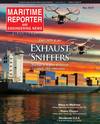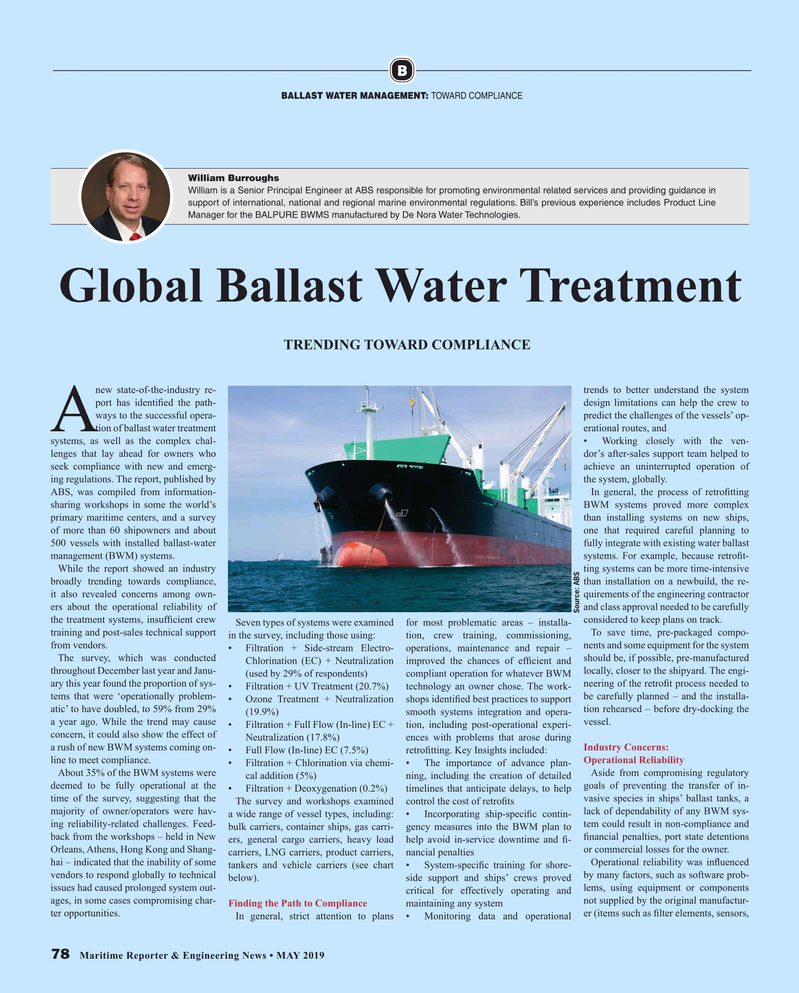
Page 78: of Maritime Reporter Magazine (May 2019)
Propulsion Annual - Green Marine Tech
Read this page in Pdf, Flash or Html5 edition of May 2019 Maritime Reporter Magazine
B
BALLAST WATER MANAGEMENT: TOWARD COMPLIANCE
William Burroughs
William is a Senior Principal Engineer at ABS responsible for promoting environmental related services and providing guidance in support of international, national and regional marine environmental regulations. Bill’s previous experience includes Product Line
Manager for the BALPURE BWMS manufactured by De Nora Water Technologies.
Global Ballast Water Treatment
TRENDING TOWARD COMPLIANCE new state-of-the-industry re- trends to better understand the system port has identi? ed the path- design limitations can help the crew to ways to the successful opera- predict the challenges of the vessels’ op-
A tion of ballast water treatment erational routes, and systems, as well as the complex chal- • Working closely with the ven- lenges that lay ahead for owners who dor’s after-sales support team helped to seek compliance with new and emerg- achieve an uninterrupted operation of ing regulations. The report, published by the system, globally.
ABS, was compiled from information- In general, the process of retro? tting sharing workshops in some the world’s BWM systems proved more complex primary maritime centers, and a survey than installing systems on new ships, of more than 60 shipowners and about one that required careful planning to 500 vessels with installed ballast-water fully integrate with existing water ballast management (BWM) systems. systems. For example, because retro? t-
While the report showed an industry ting systems can be more time-intensive broadly trending towards compliance, than installation on a newbuild, the re- it also revealed concerns among own- quirements of the engineering contractor ers about the operational reliability of and class approval needed to be carefully
Source: ABS the treatment systems, insuf? cient crew considered to keep plans on track.
Seven types of systems were examined for most problematic areas – installa- training and post-sales technical support in the survey, including those using: tion, crew training, commissioning,
To save time, pre-packaged compo- from vendors. operations, maintenance and repair – nents and some equipment for the system • Filtration + Side-stream Electro-
The survey, which was conducted Chlorination (EC) + Neutralization improved the chances of ef? cient and should be, if possible, pre-manufactured throughout December last year and Janu- compliant operation for whatever BWM locally, closer to the shipyard. The engi- (used by 29% of respondents) ary this year found the proportion of sys- neering of the retro? t process needed to • Filtration + UV Treatment (20.7%) technology an owner chose. The work- tems that were ‘operationally problem- • Ozone Treatment + Neutralization shops identi? ed best practices to support be carefully planned – and the installa- atic’ to have doubled, to 59% from 29% tion rehearsed – before dry-docking the (19.9%) smooth systems integration and opera- a year ago. While the trend may cause • Filtration + Full Flow (In-line) EC + tion, including post-operational experi- vessel.
concern, it could also show the effect of
Neutralization (17.8%) ences with problems that arose during a rush of new BWM systems coming on- Industry Concerns: • Full Flow (In-line) EC (7.5%) retro? tting. Key Insights included: line to meet compliance. Operational Reliability • Filtration + Chlorination via chemi- • The importance of advance plan-
About 35% of the BWM systems were Aside from compromising regulatory cal addition (5%) ning, including the creation of detailed deemed to be fully operational at the • Filtration + Deoxygenation (0.2%) timelines that anticipate delays, to help goals of preventing the transfer of in- time of the survey, suggesting that the vasive species in ships’ ballast tanks, a
The survey and workshops examined control the cost of retro? ts majority of owner/operators were hav- lack of dependability of any BWM sys- a wide range of vessel types, including: • Incorporating ship-speci? c contin- ing reliability-related challenges. Feed- gency measures into the BWM plan to tem could result in non-compliance and bulk carriers, container ships, gas carri- back from the workshops – held in New ers, general cargo carriers, heavy load help avoid in-service downtime and ? - ? nancial penalties, port state detentions
Orleans, Athens, Hong Kong and Shang- or commercial losses for the owner.
carriers, LNG carriers, product carriers, nancial penalties hai – indicated that the inability of some tankers and vehicle carriers (see chart • System-speci? c training for shore-
Operational reliability was in? uenced vendors to respond globally to technical below).
side support and ships’ crews proved by many factors, such as software prob- issues had caused prolonged system out- critical for effectively operating and lems, using equipment or components ages, in some cases compromising char- not supplied by the original manufactur-
Finding the Path to Compliance maintaining any system ter opportunities. In general, strict attention to plans • Monitoring data and operational er (items such as ? lter elements, sensors, 78 Maritime Reporter & Engineering News • MAY 2019
MR #5 (74-81).indd 78 5/2/2019 4:09:20 PM

 77
77

 79
79
